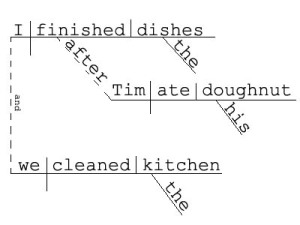 When I was a high school English teacher, the part of the curriculum I liked teaching the least was grammar. Not because I don’t understand grammar. And not because I don’t like grammar. (I was one of those weird kids who actually enjoyed diagramming sentences in middle school.)
When I was a high school English teacher, the part of the curriculum I liked teaching the least was grammar. Not because I don’t understand grammar. And not because I don’t like grammar. (I was one of those weird kids who actually enjoyed diagramming sentences in middle school.)
The reason I didn’t look forward to teaching grammar was because I had been lucky to have a great eighth grade English teacher named Mrs. Porter who taught grammar like nobody’s business. I knew that no matter what I did, there was no way I could ever live up to her patience or ability in imparting the formal rules of our written and spoken language to my own students.
Even though I understand rules such as “i before e except after c” and am a huge fan of School House Rock’s “Conjunction Junction,” my instructional wheelhouse was more about holistic approaches to reading and writing than it was standing at the blackboard diagramming sentences and asking students to complete reams of worksheets doing the same.
Regardless, grammar lessons were part of the assigned curriculum and I was required to teach them. So I did my best to make things interesting for my students, including taking a play straight out of Mrs. Porter’s playbook when it came time to teach prepositions.
Mrs. Porter had taught me and my classmates the preposition song, and of all the mnemonic devices I learned over the years, it served me best as I made my way through the maze of formalized testing in high school, college, and grad school on fill-in-the-blank questions such as, “The secret needs to be kept between _______ and ________ (he/I) or (him/me).” (The correct answer is the second pair.)
The preposition song was a list of the most common prepositions in alphabetical order set to the tune of “All around the Mulberry Bush.” It was most useful for figuring out which form of pronoun to use when speaking or writing (subject or object). Turns out, my students took to this song just as I had, and because of it, were able to choose the right answers during their own round of standardized testing.
Little did my 14-year old self sitting in Mrs. Porter’s class know how important understanding prepositions would be to my work years later as a business strategist and mentor.
Under, Over, by the Clover
If it’s been awhile since you studied prepositions, here’s a quick refresher:
A preposition describes a relationship between words in a sentence; it is a joining word that links a noun to another word in a sentence.
Common prepositions include of, to, for, and between.
While often very small and often overshadowed by sexier parts of speech such as verbs and adjectives, prepositions pack a huge punch when it comes to their influence on how English speakers create, interpret, and understand the relationships between things.
Indeed, if we were to rank elements of grammar for their power and influence on communication, prepositions would always be at the top of the heap because of their important function in imparting meaning.
Don’t Become a {Prepositional} Victim
Let’s look at an example. When things aren’t going well in our life or our business, we are most likely going to feel a slough of negative emotions ranging from anger to depression to despair. Remember when the economy crashed not that long ago? How many of us reacted with something to the effect of the following as we shook our fists at the sky:
Why is this happening to me?!
The preposition in this sentence is the word “to,” and it’s showing the relationship between “this” (i.e. the economic collapse) and “me” (the speaker). The relationship implied here is unequivocally negative. It implies being a victim — something is happening to me that I can’t control, which renders me helpless and a victim of outside circumstances.
While the victim role is great for dramatic television programs like Law and Order and Judge Judy, it’s not so useful for anyone who is serious about making a difference in the world through their career, business, or philanthropic contributions.
So let’s take a look at what happens when we replace the preposition to with the prepositionfor in this sentence:
Why is this happening for me?
Notice the immediate difference in tone, effect, and meaning?
In the first sentence, “to me” implies victimization and helplessness, whereas in the second sentence, “for me” implies opportunity, possibility and hope, despite the challenges, obstacles, or circumstances that are guaranteed to cross our paths.
Make the Switch
Looking at the economic collapse through this lens, it transforms from something horrible that happened to us and our life-business-investments into an opportunity for creative thinking about where we can take our life-business-investments. Key questions that can arise from this switch include:
- What did the crash allow us to do moving forward?
- How did it open new channels of opportunity?
- Where can we make changes to what we’re currently doing that will get us where we want to go faster/smarter/less expensively?
We can all point to very successful people who are in business today who had just launched or were in the process of launching their next big venture when the economy plummeted in 2008. And now? They are seeing enormous profit and growth despite the setbacks from that tumultuous time. They didn’t allow the crash to do something to them; they allowed the crash to do something for them.
The next time you find yourself feeling victimized in any way, examine the dialog going on in your head and try switching prepositions. Instead of saying something or someone is doing something to you and your situation, re-frame it using the preposition “for” so you can see what’s going on from an entirely different perspective.
Not only will it reduce stress and anxiety, but it may provide a new insight that makes all the difference for what’s next.
